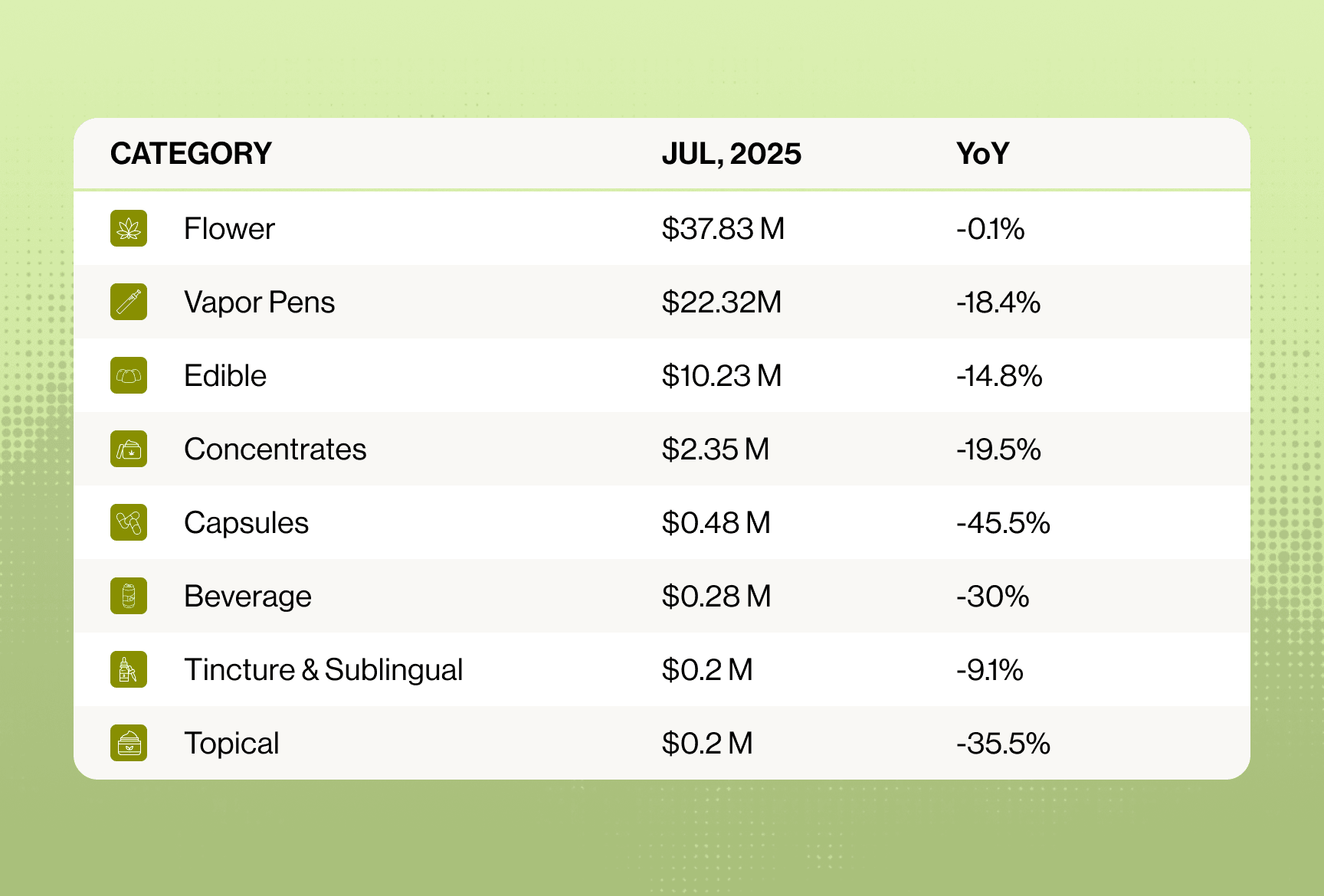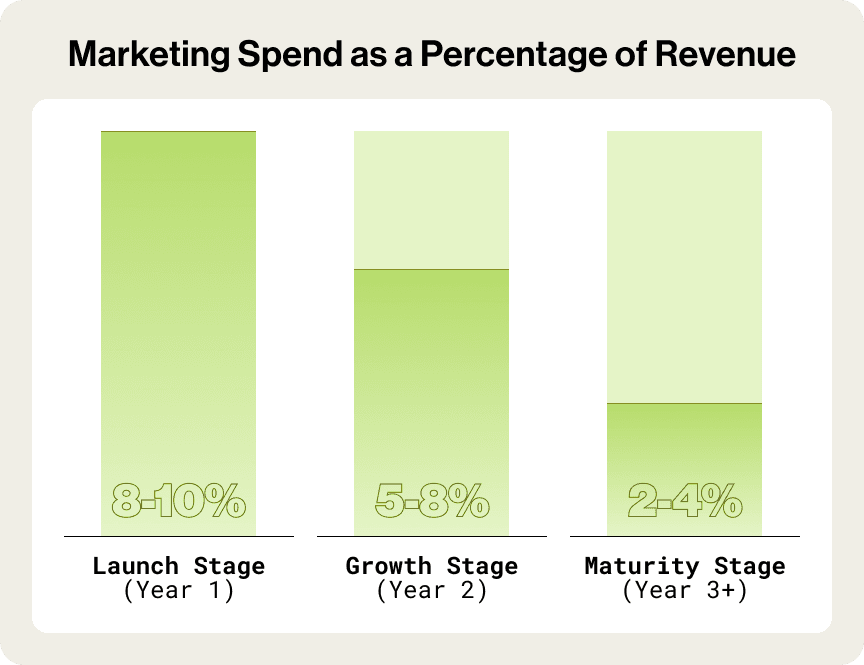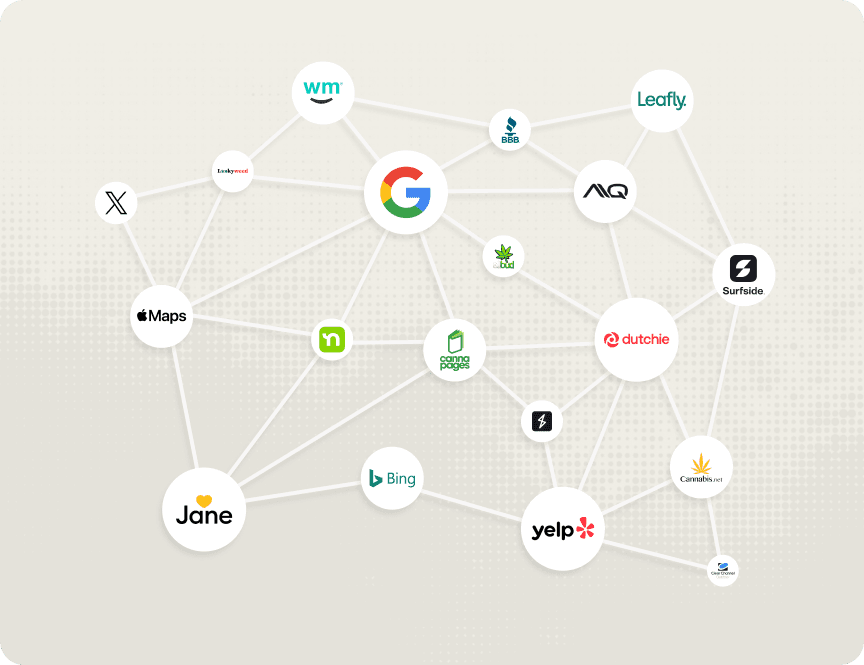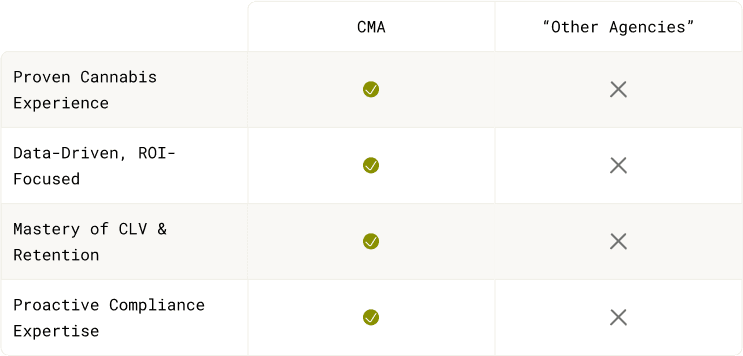Marketing to Win in New Jersey’s Crowded (& Growing) $1B+ Dispensary Market
Marketing to Win in New Jersey’s Crowded (& Growing) $1B+ Dispensary Market

Insights | 2025-08-08
Eric Allred - Head of Product

Imagine this: It’s opening week at your new dispensary in New Jersey. The shelves are lined with fresh, top-shelf flower, your budtenders are ready to impress, and the vibe inside feels exactly what the local market’s been missing.
Then reality hits. A month later, your foot traffic is steady but underwhelming. Customers stroll past your storefront to the established MSO down the block. Their parking lot is bustling with cars, lines wrap around the corner, while you’re quietly wondering why your menu updates aren’t moving the needle.
It’s not that your product can’t compete; it can. The real challenge is cutting through the noise in a market where more than 190 licensed dispensaries are already vying for attention, where state-level ad restrictions leave little room for error, and where steep taxes make every marketing dollar count.
New Jersey’s cannabis industry is a high-growth, high-barrier environment. The operators that succeed here aren’t always the ones with the deepest pockets; they’re the ones who’ve mastered the art of connecting with the right customers at the right time, building trust in their neighborhood, and running a marketing plan that follows the rules and measures results.
This guide will walk you through the essentials: understanding the state’s marketing regulations, building a strong dispensary marketing plan, executing compliant campaigns, and creating a long-term strategy that turns early traction into sustained growth.
Let's get that fresh, tasty bud flying off your shelves.
Key Takeaways
- Understand the New Jersey market's rapid license growth, MSO dominance, and competitive pricing pressures.
- Balance margins with value; taxes and high prices shape shopper decisions.
- Stock trending products like pre-rolls and infused edibles to match local demand.
- Partner with top brands (Curaleaf, Ascend, Columbia Care) to leverage their brand recognition and established in-market demand.
- Follow NJCRC ad rules to avoid costly compliance issues.
- Set clear KPIs and invest in the highest-ROI channels.
- Streamline operations to counter high startup costs and tax burdens.

Understanding New Jersey's Cannabis Marketing Regulations
Working Within New Jersey's Regulatory Framework
When New Jersey legalized adult-use cannabis in April 2022, the New Jersey Cannabis Regulatory Commission (NJCRC) built a tightly monitored market emphasizing compliance, consumer protection, and controlled expansion.
These guardrails aren’t just rules to follow; for the right operator, they create an opportunity to navigate hurdles and build an enduring edge. Rapid licensing growth has opened the market to more than 190 dispensaries. Still, tight oversight and complex operational requirements mean not every license holder has the resources to execute well. This allows agile, well-prepared retailers to outpace competitors who are stretched thin.
The challenges and advantages of vertically integrating.
While New Jersey doesn’t mandate full vertical integration for all operators, MSOs dominate prime real estate because they control cultivation, manufacturing, and retail. This level of control produces consistency and enables scale.
It also creates rigid systems, requires leverage, and creates an organizational drag that can prevent the ability to respond quickly to rapid changes in local preferences.
Independents specializing in customer-facing excellence, curating unique menus, creating personalized experiences, and responding rapidly to neighborhood demand can build loyalty and establish mindshare as a boutique, curated experience, where MSOs feel generic.
Advertising rules reshape your brand playbook.
NJCRC regulations prohibit marketing to those under 21, using imagery that appeals to minors, making unverified health claims, or promoting overconsumption. Ads must target audiences where at least 71.6% of viewers are 21+, and outdoor signage is tightly controlled. These constraints force smart dispensaries to invest in educational content, community engagement, and loyalty-driven campaigns rather than splashy promotions or visual-heavy ads.
Compliance systems impact your promotions.
New Jersey’s seed-to-sale tracking (METRC) ensures every gram is accounted for, and any promotion you run is matched on a 1-to-1 basis with current inventory. Integrating compliance systems with marketing execution means fewer mismatches, smoother operations, and increased customer trust; especially when you can share product sourcing, cultivation methods, and test results directly with shoppers.

Consumer Trends & Preferences in New Jersey
A rapidly diversifying customer base.
Since adult-use sales launched, New Jersey’s cannabis consumer profile has broadened beyond the traditional medicinal market. Headset data shows the bulk of purchases are driven by adults 25–44. However, growth is strongest among the 45–54 segment, a demographic with higher disposable income and a preference for premium, consistent products. This creates space for dispensaries offering entry-level education and committed to elevating the purchasing process.
Pre-rolls and Infused Edibles are on the rise.
Flower remains the top seller statewide, but the fastest-growing segments are pre-rolls and infused edibles. Pre-rolls attract convenience-seeking consumers, while edibles, specifically gummies, appeal to new users and experienced buyers looking for discretion. Headset data indicates pre-roll sales growth outpacing the national average, signaling that merchandising this category well can become a competitive differentiator.
Brand loyalty is genuine. Brand fatigue is real, too.
Many shoppers gravitate toward well-known MSO brands like Curaleaf, Rythm, and Ascend, partly because of their strong retail presence and consistent product lines.
However, there’s growing interest in locally grown, small-batch, and craft products (think microbrewery), especially among consumers tired of seeing duplicate SKUs across multiple retailers. Independents can win loyalty by spotlighting unique offerings and telling the story behind their products.
Tastemaking becomes an enduring edge of a commoditized market, one of the truly scarce things.
High prices, growing selection.
Despite still ranking among the priciest cannabis markets, product variety is expanding. New Jersey’s average item price hovers around $40, well above the national average of $23.50. That said, from January 2024 to 2025, there was a 158% increase in SKUs and the number of brands, signaling a widening retail assortment.
Education as a loyalty driver.
Strict ad regulations limit how you can promote, but they also amplify the value of in-store and digital education. Consumers increasingly seek dispensaries that provide clear information on product effects, dosage, and sourcing. Those who make education part of the customer journey see higher repeat visit rates and stronger word-of-mouth.
Building Your New Jersey Cannabis Marketing Plan
Most dispensary marketing plans fail before they start. When we skip the foundational work and jump straight into tactics, such as social media, text campaigns, and loyalty programs, we enable a marketing culture that wastes money and prioritizes the illusion of activity without actual progress.Establishing clear objectives and measurement frameworks allows us to hold marketing activities accountable and create a framework for prioritization. This allows us to focus our limited time and money on the channels moving the needle.
Setting Clear Objectives & Dispensary KPIs
Your data tells a story. We developed BNCHMRK, a dataset of key dispensary KPIs, to assist owners, operators, and marketing leaders in better understanding the efficacy of their marketing efforts by looking at a confluence of store-level, order-level, and loyalty-based metrics.The nine key KPIs connect marketing activities with the income statement and help govern channel-related activity. By leveraging our proprietary BNCHMRK dataset, you can develop an understanding of how various channel-specific KPIs collectively contribute to broader, overall order—and store-level performance.
Store-Level Metrics
Store-level metrics focus on overall business health and performance:
- Marketing Efficiency Ratio (MER): Measures total revenue generated per marketing dollar spent.
- Acquisition Marketing Efficiency Ratio (aMER): Evaluates revenue specifically attributable to new customer acquisition relative to marketing spend.
Order-Level Metrics
Order-level metrics analyze individual customer transactions:
- Cost Per Order (CPO): Tracks marketing spend efficiency per transaction.
- Customer Return Rate: Highlights the proportion of customers making repeat purchases, indicating marketing's effectiveness in driving ongoing customer engagement.
Loyalty & Retention Metrics
Loyalty-based metrics evaluate customer retention and long-term value:
- Customer Review Rate: Indicates the percentage of customers leaving reviews, reflecting engagement and satisfaction.
- New Customer Review Rate: Specifically measures engagement among new customers.
- Loyalty Program Opt-In Rate: Measures how effectively customers enroll in loyalty programs.
- New Customer Loyalty Opt-In: Evaluates initial engagement by new customers with loyalty programs.
- Marketing Opt-In Rate: Assesses the success of customer consent to marketing communications, highlighting potential for ongoing relationship building.
Budgeting & Resource Allocation
Your marketing budget should reflect your dispensary's business stage, competitive landscape, and specific business objectives. Aligning your marketing spend with clear KPIs ensures efficient resource use and maximum ROI.
Creating Your Dispensary's Marketing Budget
Creating an adequate marketing budget requires assessing three key factors:
- Business Stage: Are you launching, growing, or mature?
- Market Competitiveness: Is your dispensary in a densely competitive urban area or a more rural, less competitive market?
- Revenue Levels: Established dispensaries allocate around 1–2% of topline revenue to marketing. Newer dispensaries or those in competitive markets may need to allocate more.
Allocating Your Budget
Strategically distribute your budget to balance foundational growth with targeted expansion:
Foundational Channels
- Website & SEO (30–40%): Optimize for local searches, ensure intuitive navigation, and prioritize mobile responsiveness.
- Email & SMS Marketing (15–20%): Build an engaged subscriber list to drive repeat visits through personalized communication.
- Local Awareness (15–20%): Invest in local events, promotions, and community engagement.
Growth Channels
- Paid Advertising: Introduce targeted paid search, social media ads, and cannabis-specific platforms incrementally, scaling based on results.
- Loyalty & Retention: Expand loyalty programs, personalized incentives, and referral campaigns for high-ROI customer retention.

Budget Variations by Stage
Launch Stage (Year 1)
Marketing Spend: 8–10% of revenue
Focus on foundational efforts: website setup, SEO, initial customer acquisition, and establishing local brand presence.
Growth Stage (Year 2)
Marketing Spend: 5–8% of revenue
Expand paid advertising, increase SEO efforts, enhance content creation, and prioritize loyalty and retention programs.
Maturity Stage (Year 3+)
Marketing Spend: 2–4% of revenue
Refine loyalty initiatives, selectively leverage paid advertising, and focus on maximizing customer lifetime value.
Aligning your marketing budget to your dispensary’s lifecycle and market realities ensures sustainable growth, optimized ROI, and lasting success.
Choosing Technology Vendors That Power Marketing Success
The technology stack behind your dispensary isn’t just an operational necessity; it's the engine that keeps your marketing running accurately and compliantly. Selecting the right vendors for your online menu, POS system, and cannabis-focused CRM ensures that every promotion reflects real-time inventory, delivers a seamless customer experience, and integrates cleanly with your marketing channels.
Selecting Your Online Menu & POS System
Your POS should update inventory in real time across in-store registers, your website menu, and third-party marketplaces like Weedmaps or Leafly. This prevents customer frustration from out-of-stock items and builds trust that your menu reflects availability. The best POS systems generate actionable analytics, from best-selling SKUs to peak shopping hours, that can guide campaign timing, merchandising, and promotions. As an Agency Plus partner, we favor Dutchie for its robust integration and user-friendly interface.
Choosing a Cannabis-Focused CRM
A generic CRM can’t capture the nuances of cannabis buying behavior. A purpose-built, cannabis-friendly CRM allows you to segment customers by recency, frequency, monetary value (RFM), and brand and product preferences. These insights let you send personalized messages across multiple channels, from targeted emails to SMS reminders. Integrated loyalty programs and automated rewards can turn one-time buyers into long-term advocates, while tracking the lifetime value of your best customers.
Integration & Compliance
Your tech stack should work as a single, integrated system. Real-time syncing between your POS, online menu, and CRM ensures consistency across every touchpoint. Built-in compliance features like Metrc integration, age verification, and automated tax calculations reduce administrative work and help keep your marketing compliant with NJCRC regulations (NJAC 17:30-17.2), the result: fewer errors, lower risk, and more bandwidth to focus on revenue-driving activities.

Implementing Your New Jersey Dispensary Marketing Strategy
Effective cannabis marketing in New Jersey means integrating multiple channels. These channels work together to attract, convert, and retain customers while complying with NJCRC regulations. Each channel has a distinct role, but the highest-performing dispensaries make them feel seamless to the customer.
Website Design & Development – Your Digital Storefront
- First impressions build trust: Most customers form an opinion about your dispensary before they walk in, and your website is often their first stop. A clean, modern design signals professionalism and credibility.
- Mobile-first and speed-focused: More than half of cannabis-related searches happen on mobile devices, and pages loading in under two seconds see significantly higher conversion rates.
- Serve as catalog, educator, and checkout: Integrate your real-time online menu so customers know exactly what’s in stock. Pair it with educational content that answers questions about effects, dosage, and product types to position yourself as a trusted guide.
- Optimize the user journey: Intuitive navigation, precise product details, and strong calls-to-action reduce friction and guide visitors from browsing to buying.
Local SEO – How Customers Find You
- Meet intent at the moment of search: According to Google, 76% of people who search for a local business visit within 24 hours. Ranking in the top three organic results drives the majority of clicks.
- Comprehensive profiles win trust: Fully completed Google Business Profiles see more engagement, and organic search traffic consistently outperforms paid channels in driving in-store visits.
- Build local signals: Optimize your GBP, maintain consistent citations across directories, and collect authentic reviews. Create location-specific content to capture “near me” searches and highlight what makes your neighborhood unique.
Email & SMS Marketing – Bringing Back Regulars
- Convert first-timers into loyalists: Most first-time customers never return, but opt-in email and SMS subscribers are far more likely to purchase again. Automated campaigns generate up to 320% more revenue than one-off sends.
- Mobile-first messaging: SMS has open rates over 90%, and the majority of messages are read within minutes.
- Segment and personalize: Use your CRM to group customers by purchase frequency, spend, and preferences. Deliver targeted product recommendations, education, and promotions.
- Stay compliant: Use platforms that handle opt-ins, age verification, and NJCRC-specific rules so you can focus on building relationships.
Paid Advertising – Creating Visibility
- Diversify channels: Combine compliant digital placements (programmatic, cannabis marketplaces like Weedmaps/Leafly) with non-digital local options such as direct mail or event sponsorships for a more substantial brand presence.
- Reach your core radius: To maximize budget efficiency, focus on hyperlocal targeting, typically within 5–10 miles.
- Measure and adjust: Track every campaign with QR codes, custom URLs, or dedicated phone numbers to tie spend directly to store visits or online orders.
- Comply at every step: Ensure all creative meets NJCRC’s advertising rules (NJAC 17:30-17.2), avoiding imagery appealing to minors or unverified health claims.
New Jersey Dispensary Marketing FAQs
Can dispensaries advertise in New Jersey?
Yes. The New Jersey Cannabis Regulatory Commission (NJCRC) enforces some of the strictest rules in the country. Dispensaries can advertise in adult-oriented publications, sponsor compliant events, and use carefully targeted digital marketing, provided that at least 71.6% of the audience is verified to be over 21.
Campaigns must avoid imagery appealing to minors, health claims without NJCRC-approved evidence, and any content that could promote overconsumption. Outdoor advertising is restricted, and placement near schools, playgrounds, and similar facilities is prohibited (NJAC 17:30-17.2).
Are dispensaries in New Jersey profitable?
They can be, but margins are under pressure. In 2024, the state’s cannabis market surpassed $1 billion in sales, up 25% from 2023. High retail prices, growing consumer demand, and strong brand recognition for leading MSOs create an opportunity. However, high state and municipal taxes, steep startup costs, and aggressive competition (with over 190 licensed retailers by early 2025) mean profitability hinges on operational efficiency, cost control, and sustained customer acquisition.
How much does a dispensary owner in New Jersey make?
Earnings vary widely. Industry averages suggest successful adult-use dispensaries in high-traffic New Jersey markets can generate $3–5 million in annual revenue, with profit margins ranging from 8–15% depending on overhead, tax obligations, and competitive positioning. That translates to owner incomes from the low six figures to $500k+, with top performers potentially exceeding that range through multi-location ownership, effective loyalty programs, and efficient marketing operations.

Working with Cannabis Marketing Professionals
Building an effective dispensary marketing strategy in New Jersey requires specialized expertise. Regulatory compliance, cultural fluency, and a deep understanding of cannabis consumer behavior create unique challenges that a generic marketing agency can’t solve with cookie-cutter tactics. If you choose to work with a New Jersey Cannabis Marketing Agency, keep these factors front and center:
Prioritize proven cannabis experience.
When evaluating potential partners, it’s essential to understand precisely what a cannabis marketing company does and whether it's worth the investment, ensuring you choose an agency aligned with your dispensary’s unique goals.
Demand data-driven approaches.
Your agency should prioritize measurable outcomes over vanity metrics. Ask for ROI examples, acquisition cost benchmarks, and campaign performance data from comparable dispensaries. A competent cannabis agency should understand customer lifetime value, acquisition costs, and retention strategies specific to New Jersey’s market conditions.
Ensure cultural alignment.
Cannabis marketing works best when the brand voice and creative feel authentic to the community. Choose an agency that understands New Jersey’s cannabis culture and can communicate with your target audience in a way that resonates — from North Jersey’s commuter hubs to South Jersey’s more rural communities.
Verify compliance processes.
NJCRC rules should be second nature to your marketing team. Your agency must have built-in compliance protocols that prevent violations before they happen, covering everything from ad placement restrictions to the 71.6% adult-audience requirement. Proactive compliance saves you from costly enforcement actions and keeps your license in good standing.
Moving Forward with Marketing Your New Jersey Dispensary
New Jersey offers significant opportunities for operators combining strategic thinking with disciplined execution. The state’s regulatory framework creates constraints and protections, while continued consumer adoption expands the total addressable market.
Start with the fundamentals.
Clear objectives, the right technology stack, and integrated marketing channels form the foundation for sustainable growth. Success comes from consistent execution, not perfect plans.
Launch with one high-impact channel, master it, and then expand, avoiding the temptation to spread yourself too thin.
Identify your biggest challenge.
Most dispensaries face one of three main hurdles:
- Building awareness in a crowded, established market.
- Converting store visitors or website browsers into transacting customers.
- Turning first-time buyers into loyal, high-frequency shoppers.
Understanding which challenge to prioritize helps inform your process for setting goals, choosing the right tactics, and measuring progress effectively.
Build flexible, data-driven systems.
Marketing in New Jersey demands agility. Regulations can evolve, technology changes quickly, and consumer tastes shift with trends.
A flexible, analytics-led marketing approach allows you to adapt without losing momentum, whether your challenge is compliance, high acquisition costs, or competing with large MSOs.
The New Jersey cannabis market rewards action. Operators who move beyond planning, embrace consistent execution, and adjust based on data will be best positioned to thrive.
The opportunity is here; it’s time to execute.
About The Cannabis Marketing Agency
The Cannabis Marketing Agency: Cannabis marketing experts making your dispensary the one everyone talks about (in a good way).
We make your dispensary the local favorite — the spot people talk about, shop at, and keep coming back to.
+4 Years Growing Dispensaries: We don't "learn on your dime".
Trusted by Dispensaries in 18 Markets: From Cali to Mass, if it’s legal, we’ll help you win.
For DIYers who hate learning the hard way.
Want More Dispensary Customers?
We grow dispensaries like it’s our day job (because it is). Ever wonder what we’d do for yours? Let’s find out.
Get Started